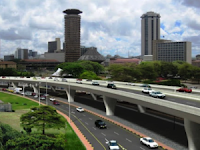European investors eye Tanzanian toll road

EUROPEAN Contractors are eyeing the US$535 million Dar-es-salaam- Chalinze toll road in Tanzania, we have learnt. In an internet posting, a Belgium based trading company Group DML, www.dml.com is shopping for a partner for a joint venture with an unnamed European contractor to develop the project on a 3P basis. Chalinze Junction: To the right is A14 leading to Tanga The company is proposing to invest in equity together with its partners. The Tanzania government, says the firm, will be a minority shareholder in the project. DML estimates that if the partners raise $150 million, they can raise the rest of the money from bank debt. They propose to use cash flows from the project as collateral. The 100 Km long Dar-Chalinze toll road is a section of the Arterial Morogoro road. This is a very busy section of the A7 highway that carries traffic to central and southern Tanzania and the neigbouring countries such as Zambia, Rwanda, Burundi, Congo, and Malawi where Dar...




.jpg)




